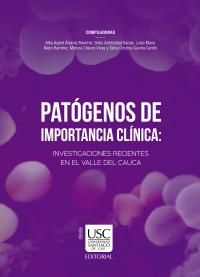Patógenos de importancia clínica: Investigaciones Recientes en el Valle del Cauca
PlumX
Palabras clave:
Antibióticos, Staphylococcus aureus, Mycobacterium tuberculosis, Salmonella entérica, Bacterias, Patógenos, SaludSinopsis
El presente libro Patógenos de importancia clínica: Investigaciones Recientes en el Valle del Cauca nace como una iniciativa para socializar los resultados obtenidos en los trabajos de investigación más recientes de los miembros del Grupo de Investigación en genética, fisiología y metabolismo –GEFIME– de la Universidad Santiago de Cali. Estas investigaciones involucran patógenos que son importantes agentes causales de infecciones y de alto impacto en la salud pública en la ciudad de Cali y en el Valle del Cauca.
Este libro consta de cinco capítulos con trabajos de investigación en bacterias resistentes a los antibióticos como Staphylococcus aureus y Mycobacterium tuberculosis y su comportamiento epidemiológico en ambientes intrahospitalarios y en poblaciones, respectivamente. En el Capítulo 3 se presenta un estudio epidemiológico que establece la presencia del virus del papiloma humano (VPH) en mucosa oral y su relación con el desarrollando cáncer oral y en el Capítulo 4 se presenta una investigación realizada con moléculas efectoras (alarmona ppGpp y la proteína DksA) de Salmonella enterica serovar Typhimurium y su influencia en la patogenicidad y la formación de biopelículas in-vitro.
Capítulos
-
Capítulo 1: Caracterización fenotípica y molecular de Staphylococcus aureus aislado de superficies del ambiente hospitalario de la red pública y privada en la ciudad de Cali
-
Capítulo 2: Perfil epidemiológico y terapéutico de pacientes con tuberculosis pulmonar en la ciudad de Cali, Colombia
-
Capítulo 3: Factores de riesgo en infección por virus del papiloma humano Tipo 16 en mucosa oral sana de pacientes atendidos en una institución odontológica de Santiago de Cali
-
Capítulo 4: Mutaciones en ppGpp Y DksA afectan la secreción de proteínas efectoras de la isla de patogenicidad 1 de Salmonella enterica serovar Typhimurium
-
Capítulo 5: Prevalencia de Staphylococcus aureus aislado de estudiantes asintomáticos del Programa De Medicina de la Universidad Santiago de Cali
Descargas
Citas
Acuña, M.; Benadof, D.; Jadue, C.; Hormazábal, J. C.; Alarcón, P.; Contreras, J. & Araya, P. (2015). Staphylococcus aureus resistente a meticilina asociado a la comunidad (SARM-AC): comunicación de los primeros cuatro casos pediátricos descritos en Hospital de Niños Roberto del Río. En: Revista chilena de infectología, 32, pp. 350-356.
Alvarez, C. A.; Barrientes, O. J.; Leal, A. L.; Contreras, G. A.; Barrero, L.; Rincón, S. & Arias, C. A. (2006). Community-associated methicillin-resistant Staphylococcus aureus, Colombia. En: Emerg Infect Dis, 12(12), pp. 2000-2001. doi:10.3201/eid1212.060814
Blanc, D. S.; Petignat, C.; Moreillon, P.; Wenger, A.; Bille, J. & Francioli, P. (1996). Quantitative antibiogram as a typing method for the prospective epidemiological surveillance and control of MRSA: comparison with molecular typing. En: Infect Control Hosp Epidemiol, 17(10), pp. 654-659.
Chen, Y. Y.; Chou, Y. C. & Chou, P. (2005). Impact of nosocomial infection on cost of illness and length of stay in intensive care units. In: Infect Control Hosp Epidemiol, 26(3), pp. 281-287. doi:10.1086/502540
Cheung, G. Y.; Wang, R.; Khan, B. A.; Sturdevant, D. E. & Otto, M. (2011). Role of the accessory gene regulator agr in community-associated methicillin-resistant Staphylococcus aureus pathogenesis. In: Infect Immun, 79(5), pp.1927-1935. doi:10.1128/IAI.00046-11
Clinical and Laboratory Standards Institute. (2005). Clinical and Laboratory Standards Institute. Wayne, Pa.: Clinical and Laboratory Standards Institute.
Collazos Marín, L. F.; Estupiñan Arciniegas, G. & Chavez Vivas, M. (2015). Characterization of Staphylococcus aureus Isolates That Colonize Medical Students in a Hospital of the City of Cali, Colombia. In: Int J Microbiol, 2015, 358489. doi:10.1155/2015/358489
Cortes, J. A.; Gómez, C. A.; Cuervo, S. I.; Lucía Leal, A. & GREBO. (2007). Implicaciones en Salud Pública de Staphylococcus aureus Meticilino Resistente Adquirido en la Comunidad en Bogotá, Colombia. En: Revista de Salud Pública, 9, pp. 448-454.
De Oliveira, A. C. y Damasceno, Q. S. (2010). [Surfaces of the hospital environment as possible deposits of resistant bacteria: a review]. En: Rev Esc Enferm USP, 44(4), pp. 1118-1123.
Fabbro-Peray, P.; Sotto, A.; Defez, C.; Cazaban, M.; Molinari, L.; Pinède, M. & Daures, J. P. (2007). Mortality attributable to nosocomial infection: a cohort of patients with and without nosocomial infection in a French university hospital. In: Infect Control Hosp Epidemiol, 28(3), pp. 265-272. doi:10.1086/512626
Hardy, O. T.; Kim, A.; Ciccarelli, C.; Hayman, L. L. & Wiecha, J. (2013). Increased Toll-like receptor (TLR) mRNA expression in monocytes is a feature of metabolic syndrome in adolescents. Pediatr Obes, 8(1), pp. 19-23. doi:10.1111/j.2047-6310.2012.00098.x
Hayden, M. K.; Blom, D. W.; Lyle, E. A.; Moore, C. G. & Weinstein, R. A. (2008). Risk of hand or glove contamination after contact with patients colonized with vancomycin-resistant enterococcus or the colonized patients’ environment. Infect Control Hosp Epidemiol, 29(2), pp. 149-154. doi:10.1086/524331
Huang, S. S., Datta, R., & Platt, R. (2006). Risk of acquiring antibiotic-resistant bacteria from prior room occupants. Arch Intern Med, 166(18), 1945-1951. doi:10.1001/archinte.166.18.1945
Lemmen, S. W., Häfner, H., Zolldann, D., Stanzel, S., & Lütticken, R. (2004). Distribution of multi-resistant Gram-negative versus Gram-positive bacteria in the hospital inanimate environment. J Hosp Infect, 56(3), 191-197. doi:10.1016/j.jhin.2003.12.004
Machuca, M. A., Sosa, L. M., & González, C. I. (2013). Molecular typing and virulence characteristic of methicillin-resistant Staphylococcus aureus isolates from pediatric patients in Bucaramanga, Colombia. PLoS One, 8(8), e73434. doi:10.1371/journal.pone.0073434
Manago, K., Nishi, J., Wakimoto, N., Miyanohara, H., Sarantuya, J., Tokuda, K., Kawano, Y. (2006). Biopelícula formation by and accessory gene regulator typing of methicillin-resistant Staphylococcus aureus strains recovered from patients with nosocomial infections. Infect Control Hosp Epidemiol, 27(2), 188-190. doi:10.1086/500620
Martínez, J. A., Ruthazer, R., Hansjosten, K., Barefoot, L., & Snydman, D. R. (2003). Role of environmental contamination as a risk factor for acquisition of vancomycin-resistant enterococci in patients treated in a medical intensive care unit. Arch Intern Med, 163(16), 1905-1912. doi:10.1001/archinte.163.16.1905
Naimi, T. S., LeDell, K. H., Como-Sabetti, K., Borchardt, S. M., Boxrud, D. J., Etienne, J., Lynfield, R. (2003). Comparison of community- and health care-associated methicillin-resistant Staphylococcus aureus infection. JAMA, 290(22), 2976-2984. doi:10.1001/jama.290.22.2976
Olarte, N. M., Valderrama, I. A., Reyes, K. R., Garzón, M. I., Escobar, J. A., Castro, B. E., & Vanegas, N. (2010). Colonización por Staphylococcus aureus resistente a la meticilina en una unidad de cuidados intensivos de adultos de un hospital colombiano: caracterización fenotípica y molecular con detección de un clon de circulación en la comunidad. Biomédica, 30, 353-361.
Sakoulas, G., Eliopoulos, G. M., Moellering, R. C., Wennersten, C., Venkataraman, L., Novick, R. P., & Gold, H. S. (2002). Accessory gene regulator (agr) locus in geographically diverse Staphylococcus aureus isolates with reduced susceptibility to vancomycin. Antimicrob Agents Chemother, 46(5), 1492-1502.
Santajit, S., & Indrawattana, N. (2016). Mechanisms of Antimicrobial Resistance in ESKAPE Pathogens. Biomed Res Int, 2016, 2475067. doi:10.1155/2016/2475067
Stegger, M., Wirth, T., Andersen, P. S., Skov, R. L., De Grassi, A., Simões, P. M., Laurent, F. (2014). Origin and evolution of European community-acquired methicillin-resistant Staphylococcus aureus. MBio, 5(5), e01044-01014. doi:10.1128/mBio.01044-14
Tokue, Y., Shoji, S., Satoh, K., Watanabe, A., & Motomiya, M. (1992). Comparison of a polymerase chain reaction assay and a conventional microbiologic method for detection of methicillin-resistant Staphylococcus aureus. Antimicrob Agents Chemother, 36(1), 6-9.
Wakefield, D. S., Helms, C. M., Massanari, R. M., Mori, M., & Pfaller, M. (1988). Cost of nosocomial infection: relative contributions of laboratory, antibiotic, and per diem costs in serious Staphylococcus aureus infections. Am J Infect Control, 16(5), 185-192.
Zhao, C., Liu, Y., Zhao, M., Yu, Y., Chen, H., Sun, Q., Wang, H. (2012). Characterization of community acquired Staphylococcus aureus associated with skin and soft tissue infection in Beijing: high prevalence of PVL+ ST398. PLoS One, 7(6), e38577. doi:10.1371/journal.pone.0038577
_____________________________________________________________________________________________
Ahmad, S. (2011). Pathogenesis, Immunology, and Diagnosis of Latent Mycobacterium tuberculosis Infection. In: Clin¬ical and Developmental Immunology, pp. 1-17.
Al-Hajoj, S.; Varghese, B.; Shoukri, M. M.; Al-Omari, R.; Al-Herbwai, M.; AlRabiah, F. & Memish, Z. (2013). Epidemiology of antituberculosis drug resistance in Saudi Arabia: findings of the first national survey. Antimicrob Agents Chemother. En: American Society for Microbiology, pp. 2161-2166.
Arenas, N. E.; Ramírez, N.; González, G.; Rubertone, S.; García, A. M. & Gómez, J. E. (2012). Estado de la coinfección tuberculosis/virus de la inmunodeficiencia humana en el municipio de Armenia(Colombia): experiencia de 10 años. En: Infectio, pp. 140-147.
Bang, D. (14 de Noviembre de 2010). The management of tu¬berculosis: epidemiology, resistance and monitoring, Rapid methods to improve treatment outcome. Obtenido de Danish Medical Bulletin: https://www.researchgate.net/publication/47699358
Cáceres, O.; Rastogi, N.; Bartra, C.; Couvin, D.; Galarza, M.; Asen¬cios, L. & Mendoza-Ticona, A. (2014). Characterization of the Genetic Diversity of Extensively-Drug Resistant Mycobacterium tuberculosis Clinical Isolates from Pulmonary Tu¬berculosis Patients in Peru. En: PLOS/ONE, pp. 15-30.
Cerezales, S. M. & Elorza, N. (2011). Tuberculosis in special populations. In: Enferm Infecc Microbiol Clin.
Cerezo, I., Jimenéz, Y.; Hernandez, J.; Zozio, T.; Murcia, M. & Rastogi, N. (2012). A first insight on the population structure of Mycobacterium tuberculosis complex as studied by spoligotyping and MIRU-VNTRs in Bogotá, Colombia. In: Infection, Genetics and Evolution, pp. 657-663.
Dramowski, A.; Morsheimer, M. M.; Jordaan, A. M.; Victor, T. C.; Donald, P. R. & Schaaf, H. S. (2012). Rifampicin-monoresistant Mycobacterium tuberculosis disease among children in Cape Town, South Africa. En: The International Journal of Tuberculosis and Lung Disease, pp. 76-81.
Falzon, D.; Jaramillo, E.; Schünemann, H. J.; Arentz, M.; Bauer, M.; Bayona, J. & Zignol, M. (2011). WHO guidelines for the programmatic management of drug-resistant tuberculosis: 2011 update. En: European Respiratory Journal, pp. 516-528.
Ferro, B.; Nieto, L. M.; Forero, L. & Sooligen, D. V. (2011). Multidrug-resistant Mycobacterium tuberculosis. Southwestern Colombia. En: Emergin Infectious Diseases, pp. 1259-1262.
Fonseca, J. D.; Knight, G. M. & McHugh, T. D. (2015). The complex evolution of antibiotic resistance in Mycobacterium tuberculosos. Int J Infect Dis. En: PublMed, pp. 94-100.
Henry, B.; Revest, M.; Dournon, N.; Epelboin, L.; Mellon, G.; Bellaud, G. & Caumes, É. (2016). Preliminary Favorable Outcome for Medically and Surgically Managed Extensively Drug-Resistant Tuberculosis, France, 2009–2014. En: Emerging Infectious Diseases, pp. 518-521.
Hupat, E. W. (2015). Infección por virus de inmunodeficiencia humana en niños y adolescentes: Más de 25 años en Chile. En: Revista Chilena de Infectología, pp. 44-56.
Marks, S.; Flood, J.; Seaworth, B.; Hirsch-Moverman, Y.; Armstrong, L.; Mase, S. & Sheeran, K. (2014). Treatment Practices, Outcomes, and Costs of Multidrug-Resistant and Extensively Drug-Resistant Tuberculosis, United States. En: Emerging Infectious Diseases, pp. 812-821.
Ocheretina, O.; Morose, W.; Gauthier, M.; Joseph, P.; D´Meza, R.; Escuyer, V. E. & Fitzgerald, D. W. (2012). Multidrug-resistant tuberculosis in Port-au-Prince, Haiti. En: Rev Panam Salud Publica, pp. 221-224.
OPS. (12 de Marzo de 2005). Organización Panamericana de la Salud. Obtenido de Colombia libre de tubercolosis 2006-2015 para la expansión y fortalecimiento de la estrategia DOTS/TAS: http://www.paho.org/col/index.php?option=com_content&view=arti-cle&i-d=1797:plan-estrategico-qcolombia-libre-de-tuberculosis-2006-2015-para-la-expansion-y-forta-lecimiento-de-la-estrategia-dotstasq&Itemid=361
Ordoñez, S. A. & López, F. A. (2013). Tuberculosis en Colombia, de la historia al entendimiento de la enfermedad. MedUNAB - Universidad Autónoma de Bucaramanga, pp.127-142.
Pérez, S. F. & López, M. P. (10 de Mayo de 2016). Vigilancia y análisis de riesgo en salud pública. Protocolo para vigilancia en salud pública, Tiberculosis. Obtenido de Insti¬tuto Nacional de Salud: http://www.clinicamedihelp.com/documentos/protocolos/PRO%20Tuberculosis.pdf
Prach, L. M.; Pascopella, L.; Barry, P. M.; Flood, J.; Porco, T. C.; Hopewell, P. C. & Metcalfe, J. Z. (2013). Rifampin mono-resistant tuberculosis and HIV co-morbidity in California. US National Institutes of Health.
Puerto, G.; Erazo, L.; Wintaco, M.; Castro, C.; Ribón, W. & Guerrero, M. I. (2015). Mycobacterium tuberculosis Genotypes Determined by Spoligotyping to Be Circulating in Colombia between 1999 and 2012 and Their Possible As-sociations with Transmission and Susceptibility to First-Line Drugs. En: PLOS/ONE, pp. 1-11.
Realpe, T.; Correa, N.; Rozo, J. C.; Ferro, B. H.; Gomez, V.; Zapata, E. & Robledo, J. (2014). Population Structure among Mycobacterium tuberculosis Isolates from Pulmonary Tuberculosis Patients in Colombia. En: PLOS/ONE, pp. 1-15.
Rojas, C. M.; Villegas, S. L.; Piñeros, H. M.; Chamorro, E. M.; Durán, C. E.; Hernández, E. L. & Ferro, B. E. (2010). Características clínicas, epidemiológicas y microbiológicas de una cohorte de pacientes con tuberculosis pulmonar en Cali, Colombia. En: Biomédica - Revista del Instituto Nacional de Salud, pp. 482-491.
Shorten, R. J.; McGregor, A. C.; Platt, S.; Jenkins, C.; Lipman, M. C.; Gillespie, S. H. & McHugh, T. D. (2013). When is an outbreak not an outbreak? Fit, divergent strains of Mycobacterium tuberculosis display independent evolution of drug resistance in a large London outbreak. In: The Journal of Antimicrobial Chemotherapy.
Torres-Chang, J. (2014). Factores de riesgo en la aparición de multidrogo resistencia en pacientes con tuberculosis pulmonar. En: Revista Médica Panacea, pp. 31-35.
Villegas, S.; Ferro, B.; Perez-Velez, C.; Moreira, C. A.; Forero, L.; Martinez, E. & Caminero, J. A. (2012). High initial multidrug-resistant tuberculosis rate in Buenaventura, Colombia: a public–private initiative. En: European Respiratory Journal, pp. 1569-1572.
Wang, L.; Zhang, H.; Ruan, Y.; Chin, D. P.; Xia, Y.; Cheng, S. & Wang, Y. (2014). Tuberculosis prevalence in China, 1990-2010; a longitudinal analysis of national survery data. En: The Lancet, pp. 1-15.
WHO. (15 de Noviembre de 2013). World health Organization. Obtenido de Report, Global Tubercolisis Control: http://www.who.int/es/
WHO. (2014). Informe mundial sobre la tubercolosis 2014. Obtenido de Organización Mundial de la Salud/World Health Organization: http://www.who.int/tb/publications/global_report/gtbr14_execsummary_summary_es.pdf
WHO. (11 de Enero de 2015). World Health Organization. Ginebra, Suiza 2014. Obtenido de Proposed Global strategy and targets for tuberculosis prevention, care and control after 2015: http://www.who.int/tb/post2015_strategy/en/
_____________________________________________________________________________________________
Ángel Vanessa, Granada Hugo Ricardo, Aristizábal D y Álvarez Alba. (2015). Factores de riesgo asociados a infección por VPH16 en mucosa oral sana de pacientes atendidos en una institución odontológica de Santiago de Cali en el año 2013. Universidad Santiago de Cali, Cali, Colombia.
Aristizábal D & Mancilla L. (2016). Detección del Virus de Papiloma Humano (VPH) tipo 16 en mucosa oral sana, lesiones verrugosopapilares, leucoplasia y cáncer escamocelular.Trabajo investigacion maestria. Cali: Universidad del Valle.
Beachler, D. C., & D’Souza, G. (2013). Natural history of oral papillomavirus infection in men. Lancet, 382(9895), 839–841. https://doi.org/10.1016/S0140-6736(13)61123-X
Bosch, F. X., Lorincz, A., Muñoz, N., Meijer, C. J. L. M., & Shah, K. V. (2002). The causal relation between human papillomavirus and cervical cancer. Bmj, (January).
Cardesa, A., & Nadal, A. (2011). Carcinoma of the head and neck in the HPV era. Acta Dermatovenerologica Alpina, Pannonica et Adriatica, 20(3), 161–173.
Castellsagué, X., Ghaffari, a, Daniel, R. W., Bosch, F. X., Muñoz, N., & Shah, K. V. (1997). Prevalence of penile human papillomavirus DNA in husbands of women with and without cervical neoplasia: a study in Spain and Colombia. The Journal of Infectious Diseases, 176(2), 353–61. https://doi.org/10.2307/30106792
Castro, J. I., Girón, C. H., & Marina, V. M. (2011). La anticoncepción hormonal como factor de riesgo para cáncer cervicouterino: Evidencias biológicas, inmunológicas y epidemiológicas. Ginecologia y Obstetricia de Mexico, 79(9), 533–539.
Ceballos, C. W., Peñaloza, J. A., Del Castillo, A. D., Murillo, S. T., & Fidalgo, H. S. (2009). Efectos psicológicos y sociales que genera la prueba del virus del papiloma humano: un estudio exploratorio. Revista Colombiana de Cancerología, 13(3), 145–156. https://doi.org/10.1016/S0123-9015(09)70133-7
D’Souza, G., Kreimer, A. R., Viscidi, R., Pawlita, M., Fakhry, C., Koch, W. M., Gillison, M. L. (2007). Case-control study of human papillomavirus and oropharyngeal cancer. The New England Journal of Medicine, 356(19), 1944–56. https://doi.org/10.1056/NEJMoa065497
Dahlstrom, K. R., Bell, D., Hanby, D., Li, G., Wang, L. E., Wei, Q.,Sturgis, E. M. (2015). Socioeconomic characteristics of patients with oropharyngeal carcinoma according to tumor HPV status, patient smoking status, and sexual behavior. Oral Oncology, 51(9), 832–838. https://doi.org/10.1016/j.oraloncology.2015.06.005
Davlin, S. L., Berenson, A. B., & Rahman, M. (2015). Correlates of HPV Knowledge among Low-income Minority Mothers with a Child 9-17 Years of Age. Journal of Pediatric and Adolescent Gynecology, 28(1), 19–23. https://doi.org/10.1016/j.jpag.2014.01.109
De Guglielmo, Z., Ávila, M., Veitía, D., Fernandes, A., Venegas, C., & de Plata, C. M. (2012). Detección de VPH en boca y cérvix de pacientes con diagnóstico citológico sugestivo de infección genital. Anales Del Sistema Sanitario de Navarra, 35(3), 445–454. https://doi.org/10.4321/S1137-66272012000300010
Escalona, L., Correnti, M., Veitia, D., & Perrone, M. (2011). Detection of human papillomavirus in gingival fluid of venezuelan HIV patients with periodontal disease. Investigacion Clinica, 52(3), 207–215.
Esquenazi, D., Filho, I. B., Carvalho, M. da G. da C., & de Barros, F. S. (2010). The frequency of human papillomavirus findings in normal oral mucosa of healthy people by PCR. Brazilian Journal of Otorhinolaryngology, 76(1), 78–84.
Gillison, M. L., Broutian, T., Pickard, R. K. L., Tong, Z., Xiao, W., Kahle, L. Chaturvedi, A. K. (2012a). Prevalence of oral HPV infection in the United States, 2009-2010. JAMA: The Journal of the American Medical Association, 307(7), 693–703. https://doi.org/10.1001/jama.2012.101
Gillison, M. L., Broutian, T., Pickard, R. K. L., Tong, Z., Xiao, W., Kahle, L., … Chaturvedi, A. K. (2012b). Prevalence of oral HPV infection in the United States, 2009-2010. JAMA : The Journal of the American Medical Association, 307(7), 693–703. https://doi.org/10.1001/jama.2012.101
González Melissa, M. L. A. y col. (2014). La infección por virus del papiloma humano afecta el pronóstico del cáncer orofaríngeo escamocelular. Revisión de la literatura. Univ Odontol., 33(71), 55–63.
León Cruz, G., Bosques Diego, O., Silveira Pablos, M., de la Torre, A. I., Soto, P., & Rodríguez, B. (2009). Incidencia de los factores de riesgo en mujeres cubanas con diagnóstico de lesiones oncológicas de cérvix. Revista Cubana de Medicina, 48(1).
León Cruz, G., & Faxas, M. E. (2004). Cáncer de cuello uterino: Aspectos inmunológicos y genéticos de mayor relevancia. Revista Cubana de Medicina.
Mancilla, L.I., Aristizabal, D., & Acevedo, S. M. (2012). Infección con papilomavirus humano tipo 16 en mucosa normal de cavidad oral en una población de la ciudad de Cali, 1(2), 11–20.
Melo G, W.S. (2009). El virus del papiloma humano. (Condilomas). Rev de Divulgación Científica y Tecnológica de la Universidad Veracruzana.
Morales, A.A., & Alejandro, R. (2015). Condiloma acuminado y embarazo. Consideraciones en la atención prenatal. Gaceta Médica Espirituana, 17(2), 12.
Mosher, W. D., Chandra, A., & Jones, J. (2005). Sexual behavior and selected health measures: men and women 15-44 years of age, United States, 2002. Advance Data, (362), 1–55.
Mosmann JP, Zayas S, Kiguen AX, V. R. (2017). Infección por Virus Papiloma Humano en mucosa oral y genital. Rev Fac Ciencias Médicas, [Jornada de Investigación Científica 2017 JICXVIII].Pag 2. ISSN1853-0605.
Nayak, S., Chandra, S., Mehrotra, D., Kumar, S., Agrawal, S. P., Kumar, S., & Goel, M. M. (2012). Effect of tobacco, alcohol, and smoking habits in oral precancer with histological proven epithelial dysplasia. Journal of Oral Biology and Craniofacial Research, 2(3), 159–162. https://doi.org/10.1016/j.jobcr.2012.10.008
OMS. (2006). Preparación de la introducción de las vacunas contra el VPH. Orientaciones normativas y programáticas para los países. Ginebra.
Preuss, S. F., Klussmann, J. P., Semrau, R., & Huebbers, C. (2011). Update on HPV-induced oropharyngeal cancer. HNO, 59(10), 1031–1038. https://doi.org/10.1007/s00106-011-2391-z
Ramos Dora Ester y López Manuel. (2013). Condiloma acuminado en adolescentes y adultos jóvenes del área de salud “Tula Aguilera” en el municipio de Camagüey. MEDISAN, 17(8), 3060.
Sam Soto, S., Ortiz de la Peña Carranza, A., & Lira Plascencia, J. (2011). Ginecología y obstetricia de México. Virus. Artículo de revisión. Ginecol Obstet Mex, 79(4), 214–224.
Soto-De Leon, S. C., Camargo, M., Sanchez, R., Leon, S., Urquiza, M., Acosta, J., Patarroyo, M. A. (2009). Prevalence of infection with high-risk human papillomavirus in women in Colombia. Clin. Microbiol. Infect, 15(1), 100–102. https://doi.org/10.1111/j.1469-0691.2008.02120.x
Syrjanen, S. (2010). Current concepts on human papillomavirus infections in children. APMIS, 118(6–7), 494–509. https:// doi.org/10.1111/j.1600-0463.2010.02620.x
Terai, M., Hashimoto, K., Yoda, K., & Sata, T. (1999). High prevalence of human papillomaviruses in the normal oral cavity of adults. Oral Microbiology and Immunology, 14(4), 201–5. https://doi.org/10.1034/j.1399-302X.1999.140401.x
Tezal, M. (2012). Interaction between Chronic Inflammationand Oral HPV Infection in the Etiology of Head and Neck Cancers. International Journal of Otolaryngology, 2012(Table 1), 1–9. https://doi.org/10.1155/2012/575242
Tristão, W., Ribeiro, R. M. P., de Oliveira, C. A., Betiol, J. C., & Bettini, J. de S. R. (2012). Epidemiological study of HPV in oral mucosa through PCR. Brazilian Journal of Otorhinolaryngology, 78(4), 66–70. https://doi.org/10.1590/S1808-86942012000400013
_____________________________________________________________________________________________
Cashel, M; Gentry, D; Hernandez, V. & Vinella, D. (1996). The stringent response in Escherichia coli and Salmonella: cellular and molecular biology. En: ASM Press Wasington DC, 1, pp. 1458-1489.
Vivero, A.; Baños, R.; Mariscotti, J. F.; Oliveros, J. C. Garcíadel Portillo, F.; Juárez, A. & Madrid, C. (2008). Modulation of horizontally acquired genes by the Hha-YdgT proteins in Salmonella enterica serovar Typhimurium. Journal of Bacteriology, 190(3), pp. 1152–6. https://doi.org/10.1128/JB.01206-07
Gordon, M. (2008). Salmonella infections in immunocompromised adults. En: The Journal of Infection, 56(6), pp. 413–422.
Gourse, R. L.; Ross, W. y Rutherford, S. T. (2006). General pathway for turning on promoters transcribed by RNA polymerases containing alternative sigma factors. Journal of Bacteriology, 188(13), pp. 4589–91. https://doi.org/10.1128/JB.00499-06
Magnusson, L. U.; Farewell, A. y Nyström, T. (2005). ppGpp: a global regulator in Escherichia coli. Trends in Microbiology, 13(5), pp. 236–42. https://doi.org/10.1016/j.tim.2005.03.008
Marcus, S. L.; Brumell, J. H.; Pfeifer, C. G. & Finlay, B. (2000). Salmonella pathogenicity islands: big virulence in small packages. Microbes and Infection / Institut Pasteur, 2(2), pp. 145-56. Retrieved from http://www.ncbi.nlm.nih.gov/pubmed/10742687
Ohl, M. E. y Miller, S. I. (2001). Salmonella: a model for bacterial pathogenesis. En: Annual Review of Medicine, 52, pp. 259-74. https://doi.org/10.1146/annurev.med.52.1.259
Paul, B. J.; Barker, M. M.; Ross, W.; Schneider, D. A.; Webb, C.; Foster, J. W. & Gourse, R. L. (2004). DksA: a critical component of the transcription initiation machinery that potentiates the regulation of rRNA promoters by ppGpp and the initiating NTP. En: Cell, 118(3), pp. 311-22. DOI: https://doi.org/10.1016/j.cell.2004.07.009
Perederina, A.; Svetlov, V.; Vassylyeva, M. N.; Tahirov, T. H.; Yokoyama, S.; Artsimovitch, I. & Vassylyev, D. G. (2004). Regulation through the secondary channel--structural framework for ppGpp-DksA synergism during transcription. En: Cell, 118(3), pp. 297–309. DOI: https://doi.org/10.1016/j.cell.2004.06.030
Roghanian, M.; Zenkin, N. y Yuzenkova, Y. (2015). Bacterial global regulators DksA/ppGpp increase fidelity of transcription. Nucleic Acids Research, 43(3), pp. 1529–36. DOI: https://doi.org/10.1093/nar/gkv003
Sands, M. K. y Roberts, R. B. (1952). The effects of a tryptophan-histidine deficiency in a mutant of Escherichia coli. En: Journal of Bacteriology, 63(4), pp. 505–11. Retrieved from http://www.pubmedcentral.nih.gov/articlerender.fcgi?artid=169301&tool=pmcentrez&rendertype=abstract
Stent, G. S. & Brenner, S. (1961). A genetic locus for the regulation of ribonucleic acid synthesis. Proceedings of the National Academy of Sciences of the United States of America, 47, 2005–14. Retrieved from http://www.pubmedcentral.nih.gov/articlerender.fcgi?artid=223254&tool=pmcentrez&rendertype=abstract
_____________________________________________________________________________________________
Al Laham, N. (2016). Detection and Antibiotic Resistance Pattern of Staphylococcus aureus and MRSA Isolated from Healthcare Workers Nares at Gaza Hospitals, Palestine. En: The International Arabic Journal Of Antimicrobial Agents, 5(4). DOI:10.3823/779
Arteaga Delgado, L.; Espinosa López, Y. y Chávez Vivas, M. (2016). Prevalencia de Staphylococcus aureus que coloniza el personal de salud de un hospital de la ciudad de Cali. En: Revista Ciencias de la Salud, 14(01), pp. 9-19. DOI:/10.12804/revsalud14.01.2016.01
Bettin, A.; Causil, C. y Reyes, N. (2012). Molecular identification and antimicrobial susceptibility of Staphylococcus aureus nasal isolates from medical students in Cartagena, Colombia. The Brazilian Journal of Infectious Diseases, 16(4), pp. 329-334. DOI/10.1016/j.bjid.2012.06.017
Buitrago, G.; Cortés, J. A.; Castillo, J. S.; Leal, A. L.; Sánchez, R. y Alvarez, C. A. (2008) Emergencia de Staphylococcus aureus resistente a meticilina con perfil comunitario en hospitales de Bogotá. Infectio, 12: p. 64.
Cercenado, E. (2009). Staphylococcus lugdunensis: un estafilococo coagulasa negativo diferente de los demás. Enfermedades Infecciosas y Microbiología Clínica, 27(3), 139-142. DOI/10.1016/j.eimc.2009.01.001
Chávez, M.; Mancilla, L. I. y Lucumí, A. (2014). Caracterización de Staphylococcus Aureus aislados del personal de salud de un hospital de mediana complejidad de la ciudad de Cali en el año 2012. En: Revista Medicina, 36(1–104), pp. 13–26. Tomado de: http://revistamedicina.net/ojsanm/index.php/Revistamedicina/article/view/20/63
Chen, C. S, y Huang, Y. C. (2012). Nasal carriage rate and molecular epidemiology of methicillin-resistant Staphylococcus aureus among medical students at a Taiwanese university. En: International Journal of Infectious Diseases, pp. 4–8. DOI./10.1016/j.ijid.2012.07.004
Clinical and Laboratory Standards Institute (CLSI). (2015). M100-S25: Performance Standards for Antimicrobial Susceptibility Testing; Twenty-Fifth Informational Supplement.
Collazos Marín, L. F.; Estupiñan Arciniegas, G. y Chavez Vivas, M. (2015). Characterization of Staphylococcus aureus Isolates That Colonize Medical Students in a Hospital of the City of Cali, Colombia. En: International Journal of Microbiology, 2015. DOI /10.1155/2015/358489
Cortés, J. A.; Gómez, C. A.; Cuervo, S. I. & Leal, A. L. (Grebo). (2007). Implicaciones en Salud Pública de Staphylococcus aureus Meticilino Resistente Adquirido en la Comunidad en Bogotá, Colombia. En: Revista de Salud Publica, 9(3), pp. 448–454.
Cruz, C.; Moreno, J.; Renzoni, A.; Hidalgo, M.; Reyes, J.; Schrenzel, J. y Arias, C. A. (2005). Tracking methicillin-resistant Staphylococcus aureus clones in Colombian hospitals over 7 years (1996-2003): Emergence of a new dominant clone. En: International Journal of Antimicrobial Agents, 26(6), pp. 457-462. DOI 10.1016/j.ijantimicag.2005.08.013
De Giusti, M.; La Torre, G.; Aurigemma, C.; Solimini, A. G.; Mannocci, A.; Marinelli, L. & Boccia, A. (2011). Knowledge, attitude and behaviour toward MRSA: Results from a survey among biomedical students and the general population. En: Journal of Public Health, 19(6), pp. 527-534.
Escobar, J.; Moreno. J.; Díaz, P.; Castro, B.; Leal, A. & Vanegas, N. (2008) Caracterización molecular de Staphylococcus aureus resistente a meticilina adquirido en la comunidad (SARM-AC) en Colombia. En: Infectio; 12: p.72.
Gurieva, T. V.; Bootsma, M. C. J. y Bonten, M. J. M. (2012). Decolonization of patients and health care workers to control nosocomial spread of methicillin-resistant Staphylococcus aureus: A simulation study. En: BMC Infectious Diseases, 12. DOI/10.1186/1471-2334-12-302
Hussein, N. R.; Basharat, Z.; Muhammed, A. H. & Al-Dabbagh, S. A. (2015). Comparative Evaluation of MRSA Nasal Colonization Epidemiology in the Urban and Rural Secondary School Community of Kurdistan, Iraq. En: PLOS ONE, 10(5), e0124920. DOI/10.1371/journal. pone.0124920
JAJ, K., & HFL, W. (2005). Nasal carriage of Staphylococcus aureus and prevention of nosocomial infections. Infectio, 33 (1) 3e8
Jiménez JN, Correa M, Rúa A, Zapata M, Riaño R, Báez P, et al. (2008) Detección molecular de Staphylococcus aureus resistente a meticilina adquirido en la comunidad (SARM-AC) en Colombia. Infectio; 12: 72.
Méndez, I. A.; HolguÍn-Riaño, D. F.; Pachón-Barinas, D. P.; Africano, F. J.; González, I. M. & Rojas, N. A. (2013) Prevalence and antimicrobial susceptibility of Staphylococcus aureus methicilin resistant isolated from medical students. En: Rev CES Med,27(1): pp.21-30.
Olaechea, P. M.; Insausti, J.; Blanco, A. & Luque, P. (2010). Epidemiología e impacto de las infecciones nosocomiales. En: Medicina Intensiva, 34(4), pp. 256-267. https:// doi.org/10.1016/j.medin.2009.11.013
Orsi, G. B.; Marrone, R.; Ferraro, F.; Tavella, F. & Colosi, A. (2008). Low colonization with MRSA among health-care workers in an Italian hospital. En: Ann Ig, 20(5), pp. 503-508.
Ortega, C.; Gonzalez, L.; Yaquich, P.; Alfaro, M.; Cares, C.; Navia M et al. (2001). Estudio de Portación Nasal de Staphylococcus aureus en Estudiantes de Medicina de la Universidad de Santiago de Chile. En: Clínica y Ciencia. 1(1): pp.10-14.
Ospina, S. (2008) Staphylococcus aureus resistente a meticilina (MRSA) colonizando manos de individuos de la población general. Infection, 12: p. 73.
Pathak, A.; Marothi, Y.; Iyer, R. V.; Singh, B.; Sharma, M.; Eriksson, B. y Lundborg, C. S. (2010). Nasal Carriage and Antimicrobial Susceptibility of Staphylococcus aureus in healthy preschool children in Ujjain, India. En: BMC Pediatrics, 10. DOI.org/10.1186/1471-2431-10-100
Ridenour, G. A.; Wong, E. S.; Call, M. A. & Climo, M. W. (2006). Duration of colonization with methicillin-resistant Staphylococcus aureus among patients in the intensive care unit: implications for intervention. En: Infect Control Hosp Epidemiol, 27(3), pp. 271-278. DOI /10.1086/500649
Tong, S. Y. C. C.; Davis, J. S.; Eichenberger, E.; Holland, T. L. & Fowler, V. G. (2015). Staphylococcus aureus infections: epidemiology, pathophysiology, clinical manifestations, and management. En: Clinical Microbiology Reviews, 28(3), pp. 603-661. DOI /10.1128/CMR.00134-14
Trepanier PT, Remblay C, Ruest A. (2013) Meticillin-resistant Staphylococcus aureus colonization among medical student. En: Canadian Journal of Infectious Diseases and Medical Microbiology.; 24(2): pp. 39-e41.
VasanthaKumari, N.; Alshrari, A. S. D.; Rad, E. G.; Moghaddam, H. G.; Van Belkum, A.; Alreshidi, M. A. & Shamsudin, M. N. (2009, November). Highly dynamic transient colonization by Staphylococcus aureus in healthy Malaysian students. En: Journal of Medical Microbiology. DOI./10.1099/jmm.0.011692-0
Wertheim, H. F. L.; Melles, D. C.; Vos, M. C.; van Leeuwen, W.; van Belkum, A.; Verbrugh, H. A. & Nouwen, J. L. (2005). The role of nasal carriage in Staphylococcus aureus infections. En: Lancet Infect Dis, 5(12), pp. 751–62. DOI 10.1016/S1473-3099(05)70295-4
Zakai, S. A. (2015). Prevalence of methicillin-resistant staphylococcus aureus nasal colonization among medical students in Jeddah, Saudi Arabia. En: Saudi Medical Journal, 36(7), 807–812. DOI/10.15537/smj.2015.7.11609


























